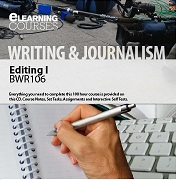 Learn to Write an Online Course
Learn to Write an Online Course
- Learn to write a course, studying from home at your own pace
- Learn from a team that has developed over 600 different courses, used by dozens of colleges around the world
Course Duration: 100 hours
Course Structure
There are 9 lessons.
- Bases for Education
- Course Writing Methodologies
- Level of Study
- Curriculum Documentation
- Course Materials
- Course Material Creation
- Reviewing and Updating Courses
- Recognition and Accreditation
- Application and Implementation.
 Course Aims
Course Aims
- Determine an appropriate basis for developing a course to suit a given need.
- Write course documentation and materials methodically and with clarity.
- Explain differences between levels of study, particularly in post secondary education.
- Write curriculum documentation for a course.
- Identify and evaluate sources for course materials and support services for a course.
- Plan and create a variety of course materials to support learning
- Establish procedures for reviewing and updating established course materials.
- Compare relative values of formal course endorsement systems.
- Plan the implementation of a developed course
It is Critical that You Recognise and Adapt to Change
 Education is changing. There is a strong sense throughout the whole world that education is critical to success in any industry; but also a serious lack of understanding on the part of parents, students, employers and politicians. They frequently do not properly understand how people learn and what the potential benefits and limitations of learning can be. Teachers do tend to understand learning, but over recent decades, there has been a move of power away from teachers controlling what is taught, to politicians and everyone else in society competing for influence over what and how education is delivered. In short, education has become increasingly politicised and often as a result, people who work in education are stressed and frustrated.
Education is changing. There is a strong sense throughout the whole world that education is critical to success in any industry; but also a serious lack of understanding on the part of parents, students, employers and politicians. They frequently do not properly understand how people learn and what the potential benefits and limitations of learning can be. Teachers do tend to understand learning, but over recent decades, there has been a move of power away from teachers controlling what is taught, to politicians and everyone else in society competing for influence over what and how education is delivered. In short, education has become increasingly politicised and often as a result, people who work in education are stressed and frustrated.
In many developed countries, trends have emerged to develop education as a “self funded” industry, an “export earning industry” or “solution to unemployment”. In some respects, moves like this can be seen as simply “hijacking” a service that should be tending to higher and more important purposes.
It is very likely that the nature and scope of education will evolve and change dramatically over coming decades, as the recent problems are recognised and responded to. The rate and nature of changes in education at all levels, from pre-school to university, are unpredictable. The one certainty is that education as an industry and employer of educators will survive.
If you seek a career in education, it is wise to develop broad skills and an attitude that is prepared for change and a nature that is capable to adapt.
 WAYS OF DEVELOPING COURSES
WAYS OF DEVELOPING COURSES
Courses can be developed in different ways, but every course uses written documents that define, describe, outline and detail the direction and contents of that course. Three types of documents that are commonly used to develop a course are course outlines, curriculum documentation and study notes:
a) Course Outlines (or descriptions)
These describe the course either as a whole, or by breaking it into its components (i.e. modules and/or lessons).
These documents are mostly used in the pre-enrolment phase e.g. for course selection or marketing. For less formal courses e.g. Adult education, hobby classes, the outline may provide a guide for teaching staff to follow as they deliver the course.
A course outline may be seen by both the student and the teaching staff.
b) Curriculum Documentation
These documents define what a course is, in every respect. Their purpose might be:
- As a reference point to be used by anyone writing course notes, study guides, or even delivering lectures or practical sessions.
- As a document to be submitted for accreditation purposes.
They are generally seen and used only by the staff of the school (teachers and administrators).
Curriculum Documentation can be costly to write, and even more costly to maintain up to date. In large education systems (eg. government accreditation systems) they are commonly written before anything else, and their development involves seeking and applying input from designated experts. For example, a curriculum advisory committee commonly sets the framework for writing this documentation then meets periodically with course writers to review their progress.
Curriculum documents are not always necessary, and if they are not required for accreditation, you should seriously consider the cost benefit to be had before deciding to allocate financial or manpower resources to this type of documentation.
c) Study Notes
These are documents such as text books, handouts, accompanying notes, study guides, work sheets or anything else which serves one or another of two purposes:
- To provide a source of information or
- To provide a guide or pathway for the student to follow.
ENROL AND LEARN